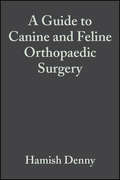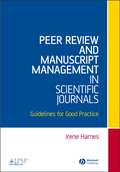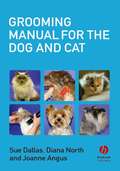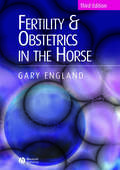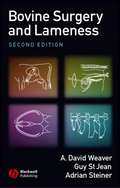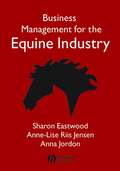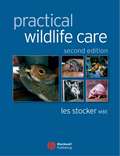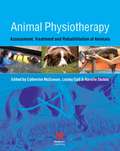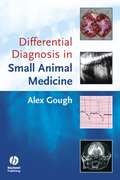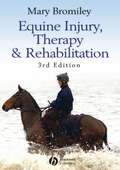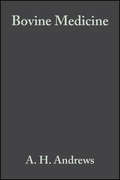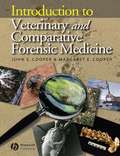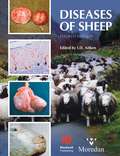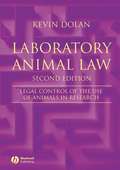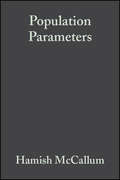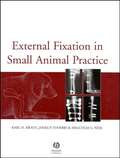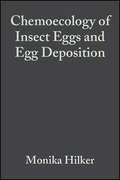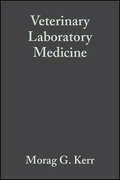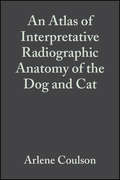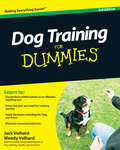- Table View
- List View
Medicine and Surgery of Tortoises and Turtles
by Stuart McArthur Roger Wilkinson Jean MeyerMedicine and Surgery of Tortoises and Turtles is an innovative and exciting new reference book on the management of chelonians. Covering everything from species identification to virus isolation techniques, it is an indispensable source of information for veterinary practitioners treating sick or injured chelonians and all those involved in captive chelonian care, chelonian conservation medicine, and scientific research. Written by leading chelonian veterinarians from around the world, this definitive book includes: Detailed sections on anatomy, physiology, husbandry, nutrition, diagnosis, diseases, anaesthesia, surgery, therapeutics and conservation. Over 1000 full-colour photographs, which take the reader through disease recognition, practical nursing, captive husbandry and common surgical conditions. Down-to-earth clinical information presented in a user-friendly format. Medicine and Surgery of Tortoises and Turtles is both a step-by-step photographic guide and a detailed source of clinical and scientific data. As well as this, it contains fascinating material that has never been published before, ensuring that it will become the primary chelonian reference book.
Handbook of Poisoning in Dogs and Cats
by Alexander Campbell Michael ChapmanThis handbook will help veterinary clinicians and their staff to manage cases of poisoning in dogs and cats. It will also help answer enquiries about potential poisonings received from concerned pet owners. The content has been compiled from over 15 000 past cases referred to the Veterinary Poisons Information Service - a 24-hour information service for veterinary surgeons. The VPIS experience is compared and contrasted with case data and reports from the literature to provide a comprehensive overview of both toxicity and management for the agents included. Each agent, or group of agents, has a separate chapter covering its effects in either the cat or the dog. In some cases the species information is combined where the clinical effects and management are identical. The chapters provide all the information necessary for the immediate management of a particular poisoning case. This includes doses at which clinical intervention is advisable and dosing regimens and indications for any drug therapy required. Thus the user will be able to access quickly all the information needed for an emergency situation without having to refer to other sources.
A Guide to Canine and Feline Orthopaedic Surgery
by Hamish Denny Steve ButterworthThis successful book, first published in 1980 and now in its fourth edition, provides an authoritative guide for busy practitioners trying to keep pace with current trends in small animal orthopaedic surgery. In this new edition Hamish Denny and Steven Butterworth have retained the same practical approach but have completely rewritten and updated the book to provide a comprehensive review of orthopaedic and spinal conditions in the dog and cat. The illustrations have also undergone a major overhaul and the many line drawings are now combined with photographs and radiographs to clarify diagnostic and surgical techniques. Although the size of the book has increased, its regional approach to problems still enables the reader to use it as a rapid reference guide. It will prove an invaluable source of information for veterinary practitioners diagnosing and treating orthopaedic and spinal problems, while postgraduate students taking further qualifications in orthopaedics will find a sound basis for their studies and further reading provided here.
Peer Review and Manuscript Management in Scientific Journals: Guidelines for Good Practice
by Irene HamesThis comprehensive yet concise book provides a thorough and complete guide to every aspect of managing the peer review process for scientific journals. Until now, little information has been readily available on how this important facet of the journal publishing process should be conducted properly. Peer Review and Manuscript Management in Scientific Journals fills this gap and provides clear guidance on all aspects of peer review, from manuscript submission to final decision. Peer Review and Manuscript Management in Scientific Journals is an essential reference for science journal editors, editorial office staff and publishers. It is an invaluable handbook for the set-up of new Editorial Offices, as well as a useful reference for well-established journals which may need guidance on a particular situation, or may want to review their current practices. Although intended primarily for journals in science, much of its content will be relevant to other scholarly areas. ?This wonderful work by Dr. Hames can be used as a textbook in courses for both experienced and novice editors, and I trust that it is what Dr. Hames intended when she prepared this beautiful book. Every scientific editor should read it.? Journal of Educational Evaluation for Health Professionals, 2008 This book is co-published with the Association of Learned and Professional Society Publishers (ALPSP) (www.alpsp.org) ALPSP members are entitled to a 30% discount on this book.
Grooming Manual for the Dog and Cat
by Sue Dallas Diana North Joanne AngusOne of the responsibilities of every dog or cat owner is that of coat care. There are many and varied coat types and there is a vast difference between the time it takes to groom a Doberman and an Old English Sheepdog, a Siamese and a Persian cat. This book provides much needed guidance for groomers, breeders and owners. It will be invaluable for those taking the City and Guilds 775 Grooming exam and animal care students of all levels. Step by step grooming/clipping techniques are described for the more popular breeds of dog and cat and in each case the technique is illustrated with photographic sequences. The book also includes allied subjects such as skin care, commonly found skin parasites and basic first aid and handling.
Fertility and Obstetrics in the Horse
by Gary EnglandFollowing on from the successful format of the previous editions, Fertility and Obstetrics in the Horse 3e is a practical and user-friendly guide to equine reproduction. From explaining the anatomy of the mare’s reproductive tract to detailing problems encountered during pregnancy, it covers all the major areas of concern as well as including the latest developments in diagnostic procedures and treatment techniques. Fully updated to take into account new developments and research; An ideal rapid reference for veterinary practitioners and veterinary students, as well as a crucial source of information and advice for those in the breeding business; New material includes expanded sections on the stallion endometritis and embryo transfer technologies, alternative methods of fertilization and insemination techniques.
Bovine Surgery and Lameness
by A. David Weaver Guy St. Jean Adrian SteinerBovine surgery is both challenging and complicated. Not only does the surgeon have to decide whether surgery is economically justified, but surgery often has to be performed in a sub-optimal environment. Following on from the worldwide success of the first edition, this new edition continues to act as a step-by-step guide to standard surgical techniques. Now with two new authors from Switzerland and North America, both the text and illustrations have been considerably expanded. In addition, special attention is given to issues relating to peri-operative analgesia and animal welfare, food safety, and drug dosages. Maintains the popular concise and accessible format of the first edition – perfect for on-the-field work; Two additional authors, with world renowned expertise in bovine surgery and lameness; Detailed instruction on the basics of effective surgery – proper instrumentation, asepsis, effective anaesthesia and essential techniques; Much more information on lameness, as well as numerous new line drawings to aid instruction.
Business Management for the Equine Industry
by Sharon Eastwood Anne-Lise Riis Jensen Anna JordonWritten by a team of consultants who combine modern business knowledge with decades of direct experience of working in the equine industry, this book bridges the gap between modern business theory and equine business practice. After providing overviews of the equestrian industry and the livery sector as a detailed example, Part I (Assessing a Business) sets out how to access the business environment, externally, competitively and with regard to its internal resources. Part 2 (Management) goes on to deal with resource management and how to go about strategic planning and marketing, concluding with an overall Business Plan. Part 3 sets out a series of case histories to illustrate the principles as discussed in Part 1 and 2. No other book applies a truly modern business approach to equine enterprise. The Authors Sharon Eastwood, Anne-Lise Riis Jensen and Anna Jordon work together at Dark Horse Consultancy, a team of equine business consultants offering a wide range of advice and services to the industry. Also available: Horse and Stable Management Fourth Edition Jeremy Houghton Brown, Sarah Pilliner and Zoe Davies 1 4051 0007 9 978 14051 0007 6 Teaching Jumping Jane Houghton Brown 0 632 04127 7 978 0632 04127 5 Horse Nutrition and Feeding Second Edition Sarah Pilliner 0 632 05016 0 978 0632 05016 1 Equine Science Second Edition Sarah Pilliner and Zoe Davies 1 4051 1944 6 978 14051 1944 3 Introduction to Horse Biology Zoe Davies 1 4051 2162 9 978 14051 2162 0 Horse Business Management Third Edition Jeremy Houghton Brown 0 632 05826 9 978 0632 05826 6
Practical Wildlife Care
by Les StockerWildlife care and rehabilitation is often on a one-to-one basis and involves a lot of time, care and skill. However, for many years, care of injured wildlife was regarded as a low priority and euthanasia was the recommended option. A lot has changed over the past twenty years and now caring for wildlife casualties is part of everyday life in many veterinary practices. Following on from the major success of the first edition, this second edition provides even more useful information on wildlife care and rehabilitation. As well as covering a whole range of species, with sections on birds, mammals, reptiles and amphibians, this edition now includes information on many ‘alien’ species appearing in the British countryside such as wallabies, wild boar and exotic reptiles. In this edition: Essential guidance on handling, first aid, feeding and releasing, and many other disciplines not featured in veterinary or nursing training Full of helpful tips from an expert in wildlife rehabilitation who has unparalleled practical experience Expanded chapters on the care of all species – particularly casualty badgers, otters and hedgehogs – and more comprehensive guidance on rearing orphaned mammals and birds Lots more colour pictures to aid in management and care techniques and the latest information on zoonotic diseases from around the world
Breeding Horses
by Mina Davies-MorelWritten for students and all with a general interest in breeding horses, this book sets out to provide a basic understanding with sufficient practical information for beginners to get started. Enough reproductive physiology of the mare and stallion is included to clarify the management techniques which are explained later in the book, but unnecessary details are avoided. Artificial insemination and embryo transfer are also explained, as are selecting the broodmare and stallion, management at covering and during pregnancy, and post-partum care of the mare and foal.
Animal Physiotherapy: Assessment, Treatment and Rehabilitation of Animals
by Catherine McGowan Lesley Goff Narelle StubbsAnimal Physiotherapy is an essential reference guide for physiotherapists looking to apply the proven benefits of physiotherapy to the treatment of companion and performance animals. Animal Physiotherapy is a growing profession of physiotherapists who have broadened their expertise from the well-established human sphere to animals. The positive perception of physiotherapy in the human sphere, together with an increased awareness of options and expertise available for animals has resulted in a strong demand for physiotherapy for animals. For the physiotherapist this book provides essential applied background information on animal behaviour, nutrition, biomechanics and exercise physiology. For veterinarians and others who work with animals, the book reviews the scientific principles behind the practice of physiotherapy, and what it can achieve. Includes reviews of different physiotherapy techniques, drawing on both human and animal literature; Discusses approaches in small animal medicine as well as for elite equine athletes; Includes applied evidence-based clinical reasoning model, providing case examples
Differential Diagnosis in Small Animal Medicine
by Alex GoughVeterinary practitioners and students are presented with many different and complex cases, and are expected to offer an accurate diagnosis quickly. The differential diagnosis list is one of the most important aspects of the problem-oriented approach to clinical diagnosis. Finding good lists in a readily available form can be difficult, and can involve laborious reference to multiple texts and sources. Differential Diagnosis in Small Animal Medicine brings this information together in one place in an easy reference format. A rapid reference that concentrates solely on differential diagnosis lists of major problems in small animal medicine; Details differential diagnoses from diverse findings such as history, physical examination, diagnostic imaging and laboratory test results; Includes radiographs, ultrasounds, selected diagnostic algorithms colour pictures and suggestions for further testing Saves time spent searching multiple texts and sources, by bringing the information together in one place in an easy reference format.
Equine Injury, Therapy and Rehabilitation
by Mary BromileyMary Bromiley’s book remains essential reading for both professionals and the general riding community. This new edition builds on the huge success of the previous editions, first published in 1987. Fully updated to reflect recent technological advances in diagnostic ability, as well as the proven physiological effects of light, magnetic fields and electrical currents on body tissues. This information allows readers to both understand and make an informed choice of appropriate therapy following a diagnosed injury. The original edition was the first book on the subject and it has continued to be a bestseller. Covers a subject that is of worldwide interest. The author is recognised as a pioneer at the forefront of this type of treatment.
Bovine Medicine: Diseases and Husbandry of Cattle
by Anthony H. Andrews Roger W. Blowey Hugh Boyd Roger G. EddyBovine Medicine provides practical and comprehensive information on cattle disease and production and is a key reference for all large animal vets. Since the first edition was published in 1991 there have been significant improvements in disease control and management of cattle. Almost all parts of the book have been updated and completely rewritten. There are new chapters on surgery, embryo transfer, artificial insemination, ethno-veterinary medicine and biosecurity, and a new consolidating chapter on the interaction between the animal, environment, management and disease. The previous edition has sold all over the world, and as a result of this a greater emphasis has been placed on conditions and their treatment in areas other than temperate regions. A new section entitled "Global Variation in Cattle Practice" has been included with contributors discussing bovine medicine practice in their part of the world. All in all this is an outstanding resource for any practising vet and an excellent reference for veterinary students.
Skin Diseases of the Dog and Cat: Clinical and Histopathologic Diagnosis
by Thelma Lee Gross Peter J. Ihrke Emily J. Walder Verena K. AffolterDiagnosis is often the most challenging part of dermatology. Diagnostic dermatology melds both clinical and histopathologic diagnosis by correlating the clinical and microscopic features of skin disease. This book is a heavily illustrated comprehensive overview of clinical dermatology and dermatopathology that will provide the reader with the tools to accurately diagnose skin disease in the dog and cat. The book will prove an indispensable reference for veterinary dermatologists, diagnostic pathologists, and small animal practitioners who seek to improve their skill in diagnostic dermatology. Completely revised second edition, with many new disease descriptions Now with colour clinical photographs illustrating all of the non-neoplastic skin diseases (previous edition had black and white photographs only) Written by internationally renowned experts, it provides a comprehensive overview of clinical dermatology and dermatopathology for all those interested in skin diseases of dogs and cats.
Introduction to Veterinary and Comparative Forensic Medicine
by John E. Cooper Margaret E. CooperIntroduction to Veterinary and Comparative Forensic Medicine is a ground-breaking book in an emerging new speciality. It reflects the increasing demand for expert opinion by veterinarians and others in courts of law and elsewhere on such matters as: · wildlife conservation, · welfare of, and alleged cruelty to, animals, · insurance, certification and malpractice · the identification of live and dead species or their derivatives. It also discusses and analyses current concern over possible links between domestic violence and abuse of animals. Throughout the book the emphasis is on the need for a systematic and thorough approach to forensic work. A particular feature is practical advice, with protocols on dealing with common problems, together with case studies, various appendices and an extensive bibliography. A vital reference for members of the veterinary profession, lawyers, enforcement bodies and welfare and conservation organisations. The comparative aspects provide an important source of information for those working in human forensic medicine and the biological sciences.
Wilson's Practical Meat Inspection
by William G. WilsonAwareness of food safety and its economic significance has never been higher after public alarm following the BSE crisis and the Foot-and-Mouth outbreak. This classic text is an essential handbook for all persons involved in meat inspection and the meat industry seeking information on the latest diseases and parasites. Now in its seventh edition, it has been revised to reflect the latest knowledge of BSE, Foot-and-Mouth and TB. Information on specific diseases, parasites and physiological processes has been updated and the latest legislation included. As well as this, a new chapter on illegal meat imports has been added, with the aim of helping the detection of illegal meat and ensuring its removal from the food chain. Well-established and respected reference for all those seeking hands-on, practical information; Details the latest reports on diseases and includes crucial information on meat related legislation.
Diseases of Sheep
by Ian AitkenFirst published in 1983, Diseases of Sheep has become a definitive reference book on sheep diseases. This new edition has been revised and updated to maintain its original core structure and its international approach to the many diseases which affect sheep. Any veterinary surgeon or agriculturalist who works with sheep will continue to find the information in this book the most authoritative and comprehensive available. Known to many as the "Moredun Sheep Book" because of its association with the Moredun Research Institute, long recognised as a centre of excellence in sheep disease research. Special attention is given to specific regional disease problems in the Middle East, Southern Africa, Australia, New Zealand, North America and South America. Covers technical aspects of disease prevention and treatment, including uncommon diseases, as well as sheep welfare issues.
Laboratory Animal Law: Legal Control of the Use of Animals in Research
by Kevin DolanPraise for the first edition: “It is hard to see how anyone with responsibilities under the Animals (Scientific Procedures) Act could manage without a book such as this.” Michael Balls, review published in Atla “The strength of the book lies in the way Kevin Dolan brings his experience to bear blending information from various sources.” Patrick Sinnett-Smith, review published in RDS News Written by the leading expert in this field, this is the only book providing practical guidance on the legal obligations of caring for laboratory animals. Up-to-date information on all relevant UK legislation and guidelines is given, with the main emphasis being on the interpretation of the Animals (Scientific Procedures) Act 1986. New to this edition: *Emphasis throughout is now on the practical application of legal controls of the use of animals in research. *Updated where relevant to keep in line with new welfare legislation. *Coverage of current format of application for personal and project licences. *Expanded coverage of Certificates of Designation. *Impact of the Freedom of Information Act is discussed. A vital resource for all those involved with the use of animals in research, and especially those studying for qualifications or licences in this field.
Population Parameters: Estimation for Ecological Models (Ecological Methods and Concepts #3)
by Hamish McCallumEcologists and environmental managers rely on mathematical models, both to understand ecological systems and to predict future system behavior. In turn, models rely on appropriate estimates of their parameters. This book brings together a diverse and scattered literature, to provide clear guidance on how to estimate parameters for models of animal populations. It is not a recipe book of statistical procedures. Instead, it concentrates on how to select the best approach to parameter estimation for a particular problem, and how to ensure that the quality estimated is the appropriate one for the specific purpose of the modelling exercise. Commencing with a toolbox of useful generic approaches to parameter estimation, the book deals with methods for estimating parameters for single populations. These parameters include population size, birth and death rates, and the population growth rate. For such parameters, rigorous statistical theory has been developed, and software is readily available. The problem is to select the optimal sampling design and method of analysis. The second part of the book deals with parameters that describe spatial dynamics, and ecological interactions such as competition, predation and parasitism. Here the principle problems are designing appropriate experiments and ensuring that the quantities measured by the experiments are relevant to the ecological models in which they will be used. This book will be essential reading for ecological researchers, postgraduate students and environmental managers who need to address an ecological problem through a population model. It is accessible to anyone with an understanding of basic statistical methods and population ecology. Unique in concentrating on parameter estimation within modelling. Fills a glaring gap in the literature. Not too technical, so suitable for the statistically inept. Methods explained in algebra, but also in worked examples using commonly available computer packages (SAS, GLIM, and some more specialised packages where relvant). Some spreadsheet based examples also included.
External Fixation in Small Animal Practice
by Karl H. Kraus James P. Toombs Malcolm G. NessExternal fixation is one of the most versatile treatment options for fracture repair in small animals. The advantages include enhancing both the mechanical and biologic environment for optimal fracture healing. Veterinary external fixation is evolving and there are now improved techniques, better instrumentation and a continuing reduction in the incidence of complications. General veterinary practitioners can master the techniques and equipment costs are low. This book offers a highly practical guide to the use of linear external fixators in small animal practice. Divided into two sections, the first section reviews essential knowledge and technical details that underpin the successful treatment of a clinical case. The second is a collection of case studies selected to show the range of fracture types and fixator systems available. Within each case there is discussion of treatment options and clinical decision-making. Follow-up radiographs then provide invaluable insight into the normal radiographic appearance of healing and healed fractures. The authors have put together an intensely practical book that will no doubt prove to be the perfect learning tool for the surgical resident and practising veterinarian. Key features: A unique approach ensures the book is both practical and easy to read Written to appeal to practising veterinarians world-wide Contains over three hundred high quality radiographs Structured for detailed study or quick reference
Chemoecology of Insect Eggs and Egg Deposition
by Monika Hilker Torsten MeinersThis is the first book focusing on the chemoecology of insect eggs and egg deposition. It covers a wide range of different issues including herbivorous and carnivorous insects, social insects and those of medical and veterinary importance. The knowledge compiled in this book may promote future studies on evolutionary aspects on insect reproductive behaviour as well as on controlling insect pests by targeting the egg stage.
Veterinary Laboratory Medicine: Clinical Biochemistry and Haematology
by Morag G. KerrVeterinary Laboratory Medicine covers all aspects of basic clinical biochemistry and haematology, and includes test-by-test interpretation of laboratory results. Information is provided on sampling techniques, the selection and use of an external laboratory, as well as near-patient testing and the practice laboratory. Also included are step-by-step instructions for most commonly used point-of-care tests, a guide to the evaluation of instruments for in-practice use, and a detailed explanation of the principles of impedance counting and photometric analysis. The book will be ideal for practitioners who require a guide to laboratory work, and for veterinary students studying laboratory medicine and clinical pathology. The second edition has been fully updated to reflect advances in diagnostic techniques, and includes new chapters on diagnostic endocrinology and feline virus testing as well as a much expanded chapter on diagnostic profiling and pattern recognition.
An Atlas of Interpretative Radiographic Anatomy of the Dog and Cat
by Arlene Coulson Noreen LewisA good basic knowledge of radiological anatomy is essential for both the specialising and non-specialising veterinary audience. This comprehensive and general practice orientated reference book which provides detailed radiographic guidance on the normal clinical anatomy of the dog and cat. In addition to numerous projections of plain and contrast studies, this atlas includes detailed observations of the normal range of variations seen in the juvenile animal, differences between breeds and descriptions of the range of anatomical variations commonly encountered in veterinary practice. The clinical utility of the book has been greatly enhanced by the use of line drawings corresponding to the relevant radiographs and schematic drawings of those structures not normally visible in plain films. The authors, both with extensive teaching experience in postgraduate veterinary radiology, describe procedures and techniques routinely available in general veterinary practice. Monitored for anatomical accuracy throughout, this atlas provides a single volume reference for the general practitioner, undergraduate or postgraduate veterinary surgeon.
Dog Training For Dummies
by Jack Volhard Wendy VolhardMake training fun and effective This friendly guide shows you how to select the right training method for your dog, based on his unique personality, to reach your desired goals. Whether you want to teach Buddy to sit or master retrieving, you'll get expert training tips and techniques for you and your dog — to ensure a mutually respectful relationship with your four-legged friend. Concentrate on canines — discover why your dog acts the way she does, understand her nutritional needs, and ready yourself for the task of training your dog Prep for your pup — prepare your home for your puppy's arrival, discover the importance of socialization, and get started on housetraining Put your best paw forward — teach basic commands like Sit, Stay, and Down, and get the scoop on how to deal with doggie don'ts like chewing, digging, and excessive barking Take training to the next level — get involved in organized dog activities and competitions, where you'll both show off impressive tricks like retrieving, figure 8s, and much more Open the book and find: Step-by-step instructions for teaching your dog basic commands Helpful advice on crate training Safe ways to address aggression and separation anxiety Tips for teaching Buddy to behave himself around people and other dogs Techniques to keep your senior dog feeling young Health issues that can interfere with training Experts to turn to for training help Learn to: Use positive reinforcement as an effective teaching tool Select the gear you need for training success Teach the basics including Sit, Stay, and Down Eliminate unwanted behavior


